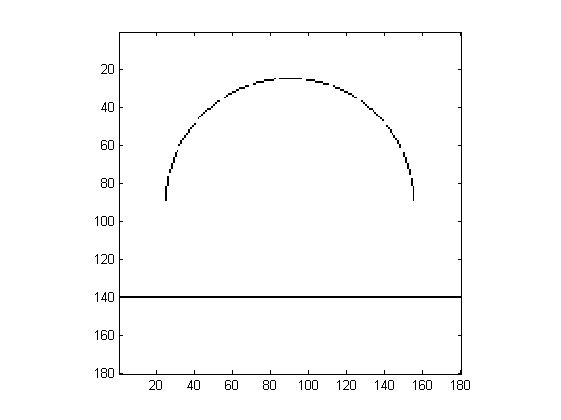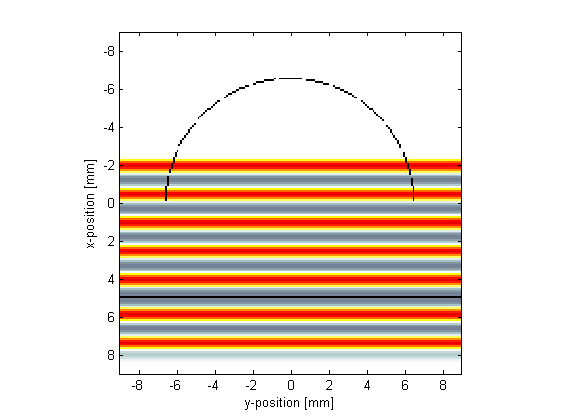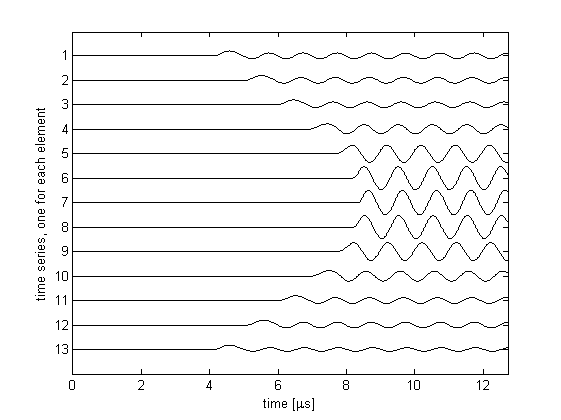

| k-Wave Toolbox |
 
|
| On this page… |
|---|
|
Define a focussed array of directional elements |
This example demonstrates the use of k-Wave to compute the outputs from a curved detector array which consists of several elements, each of which consists of a number of grid points.
To start with, a curved detector array is defined using the makeCircle function.
% define a semicircular sensor centered on the grid semicircle_radius = 65; % [grid points] arc = makeCircle(Nx, Ny, Nx/2, Ny/2, semicircle_radius, pi);
The grid points making up this curved array are divided up between a number of elements. This is achieved by calculating the angles from each grid point to the focus of the array and grouping the grid points with similar angles.
% find total number and indices of the grid points constituting the
% semicircle
arc_indices = find(arc == 1);
Nv = length(arc_indices);
% calculate angles between grid points in the arc and the centre of the grid
arc_angles = atan((kgrid.y(arc_indices))./kgrid.x(arc_indices));
% sort the angles into ascending order, and adjust the indices accordingly
[sorted_arc_angles,sorted_index] = sort(arc_angles);
sorted_arc_indices = arc_indices(sorted_index);
% divide the semicircle into Ne separate sensor elements
Ne = 13;
sensor.mask = zeros(Nx,Ny);
for loop = 1:Ne
% the indices of the grid points belonging to one element.
% (There is a two grid point gap between the elements.)
grid point_indices = sorted_arc_indices(floor((loop-1)*Nv/Ne)+2:floor(loop*Nv/Ne)-1);
% add the element to the sensor.mask
sensor.mask(grid point_indices) = 1;
end

To model a plane wave source parallel to one of the grid dimensions, two
steps are necessary. First, source.p_mask is set so that it
stretches across the domain.
source.p_mask = zeros(Nx,Ny); source.p_mask(140,:) = 1;
Secondly, the inputs to the simulation are set so that the perfectly matched
layer is turned off on the two sides that source.p_mask meets.
input_args = {'PMLAlpha', [2 0], 'DisplayMask', display_mask, 'PlotScale', [-0.75 0.75]};
The simulation is run and the time series are measured for every non-zero
grid point in sensor.mask. These time series are then allocated to
their relevant elements, and averaged together.
sensor_data = kspaceFirstOrder2D(kgrid, medium, source, sensor, input_args{:});
% split up the data, recorded on all the grid points, between the elements
element_data = zeros(Ne,Nt);
for loop = 1:Ne
% the indices of the sensor grid points in the sensor mask
sensor_indices = find(sensor.mask==1);
% the indices of the grid points belonging to one element.
grid point_indices = sorted_arc_indices(floor((loop-1)*Nv/Ne)+2:floor(loop*Nv/Ne)-1);
% indices of sensor_data that refer to the data for this element
data_indices = zeros(length(grid point_indices),1);
for loop2 = 1:length(grid point_indices)
data_indices(loop2) = find(sensor_indices == grid point_indices(loop2));
end
% for one element per loop, average the time series from each of the
% element's grid points to give one time series for the whole element
element_data(loop,:) = mean(sensor_data(data_indices,:),1);
end

The time series corresponding to the different elements are plotted. The directionality introduced by the large size of the detector (because it averages the incoming wave over its area) is clearly seen.

 |
Sensor Element Directivity in 2D | Photoacoustic Image Reconstruction |  |
© 2009-2014 Bradley Treeby and Ben Cox.